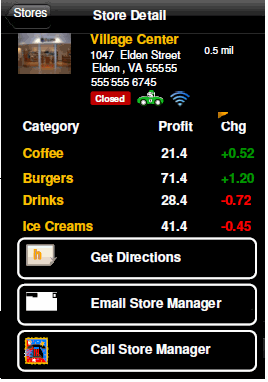
A document displayed on an iPhone or iPad can interact with the applications that are installed with the iPhone or iPad. For example, a document can send addresses to Google Maps for directions or open a video on YouTube. These applications include:
Phone
SMS (text)
Maps
Video player
Note: Only the Email and Maps applications are available on the iPad.
To allow users to open an iPhone or iPad application in a document, create a hyperlink. A hyperlink connects a text field or an image to a web page (the target). When the document is viewed on an iPhone or iPad, the user can click the control to navigate to the target.
For example, you create a document for the regional managers for a chain of stores. This document contains information about each of the stores in the manager’s region. The information includes the store’s address, phone number, the store manager’s email address, its inventory figures, and so on. When the regional manager views this document on his iPhone, he can click a link to:
View a map of the store’s location and get directions from his present location
Email the store manager
Call the store

Note: Links created using the Link Editor are not supported in MicroStrategy Mobile for iPhone, except for links created in:
A report displayed on an iPhone
A report displayed as an Interactive Grid widget on the iPhone
An Interactive Grid widget on the iPhone
Open the document in Design or Editable Mode.
To use a text field for the hyperlink, complete the following steps (see the next step for instructions to add an image instead):
From the Insert menu, select Text.
Click
in the section of the document where you want to place the text field.
If you click and drag in the section, you can size the text field.
Note: To ensure that the area of a link is large enough
to recognize a user selecting it, make sure it has a height and width
of at least 40 pixels.
Type the text to be displayed to users into the text field. You can add static text, dynamic text (in the form of data fields and auto text codes), or a combination to the text field:
To add static text, type the static text into the text field.
To add a data field, drag and drop a dataset object from the Dataset Objects panel into the text field.
To add an auto text code, from the Insert menu, select Auto-text, then select the code to insert.
Note: For background information about adding text to documents, see About adding text and data to documents.
To use an image for the hyperlink, complete the following steps:
From the Insert menu, select Image.
Click in the section of the document where you want to place the image. If you click and drag in the section, you can size the image. The Properties and Formatting dialog box opens.
Type the address of the image file to insert in the Source field.
Click
OK. The image appears in the document.
Note: For background information about adding images to
documents, see
Adding images to
documents.
Right-click the text field or image that you just added, and select Properties and Formatting. The Properties and Formatting dialog box opens.
From the left, click General, then select the Is hyperlink check box.
In the Hyperlink field, delete the http:// text that is automatically filled in. Following the syntax in the table below, type the hyperlink into the Hyperlink field. You can type static text, dynamic text (in the form of data fields and auto text codes), or a combination to the text field, as described below.
To add static text, type the static text into the text field.
To add a
data field (that is, an
object from a dataset report), type the object’s name within braces, such
as {Revenue} or {Region}.
The name must match either the name of an object in a dataset or its alias.
If either name contains spaces or special characters, you must type it
in square brackets [ ] within the braces, as in {[Manager
Name]}.
Note: A special character is any character other than a
- z, A - Z, 0 - 9, #, _, and . (period).
To add an auto text code (that is, document and dataset report information), type the code within braces. As with data fields, if an object’s name contains spaces or special characters, enclose it in square brackets within the braces. Refer to the following sections for lists of the available auto text codes:
Click OK to return to the document.
When you create a hyperlink to open an iPhone or iPad application, you must use the syntax provided in the table below. Two examples are included for most hyperlink types. The first example replaces the italicized variables in the syntax with specific, static text, while the second replaces it with an attribute, so that the hyperlink can change according to the data in your document.
|
Task |
Hyperlink Syntax |
|
Compose an email |
mailto:EmailAddress Examples:
|
|
Compose an email with a subject, message, and cc address |
mailto:EmailAddress?cc=EmailAddress&subject=SubjectLine&body=Message Example:
|
|
Call a phone number (iPhone only) |
tel:PhoneNumber Examples:
|
|
Use SMS links (iPhone only) |
sms:SMSNumber Examples:
|
|
Display a location in Google Maps |
http://maps.google.com/maps?q=City Examples:
|
|
Get directions from Google Maps |
http://maps.google.com/maps?daddr=Destination&saddr=Start Examples:
|
|
Open a video |
Type the URL of the video in the Hyperlink field. Example:
|
Related topic